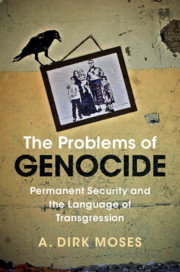Book contents
- The Problems of Genocide
- Human Rights in History
- The Problems of Genocide
- Copyright page
- Contents
- Preface
- Introduction
- Part I The Language of Transgression
- 1 The Language of Transgression, 1500s to 1890s
- 2 The Language of Transgression, 1890s to 1930s
- 3 Raphael Lemkin and the Protection of Small Nations
- 4 The Many Types of Destruction
- 5 Inventing Genocide in the 1940s
- Part II Permanent Security
- Part III The Language of Transgression, Permanent Security, and Holocaust Memory
- Index
5 - Inventing Genocide in the 1940s
from Part I - The Language of Transgression
Published online by Cambridge University Press: 07 January 2021
- The Problems of Genocide
- Human Rights in History
- The Problems of Genocide
- Copyright page
- Contents
- Preface
- Introduction
- Part I The Language of Transgression
- 1 The Language of Transgression, 1500s to 1890s
- 2 The Language of Transgression, 1890s to 1930s
- 3 Raphael Lemkin and the Protection of Small Nations
- 4 The Many Types of Destruction
- 5 Inventing Genocide in the 1940s
- Part II Permanent Security
- Part III The Language of Transgression, Permanent Security, and Holocaust Memory
- Index
Summary
“Genocide” became an option to codify the Martens Clause when Axis Rule was published in late 1944. But “war crimes,” “crimes against humanity,” and “crimes against peace” were the favored options among Allied authorities in the first half of the 1940s. Genocide’s breakthrough as a politically viable legal concept was dependent less on Lemkin’s well-known energetic advocacy than on its repositioning in a field of conceptual options over which he had no control. Lemkin’s achievement was not to invent a “new word … to denote an old practice in its modern development” but to contrive a conceptual artifice that enabled a new coalition of small states and civil society groups like the WJC to create a new reality by combining the “crippling” and “extermination” of nations after the disappointing outcome of the Nuremberg Trials in 1946. In doing so, he introduced definitional instability into the concept. Genocide’s redefinition in the UN Convention negotiated between 1947 and 1948 made the Holocaust the archetype of genocide.
Keywords
- Type
- Chapter
- Information
- The Problems of GenocidePermanent Security and the Language of Transgression, pp. 201 - 240Publisher: Cambridge University PressPrint publication year: 2021



